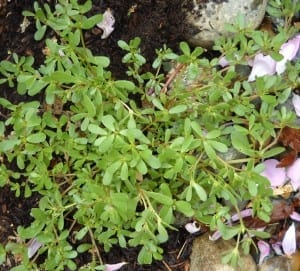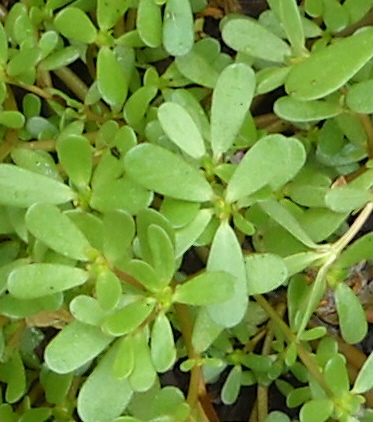One of the realities of gardening while cohabiting with the local fauna is that things do not always go as planned. Jean had a freshly sprouted planter full of basil on the back porch about two inches high. Earlier this week I received an email saying that every last plant had been eaten overnight. The wild rabbits had enjoyed a lovely midnight snack. When living with nature, those are the adventures.
 Like Harvey Wallbangers and blanc mange, purslane is a food that although once very popular, has fallen out of fashionable favour, more often being relegated to the weed category. An esteemed food in its native India, and Persia, archaeologists have found the seeds of purslane while working excavations dating back thousands of years.
Like Harvey Wallbangers and blanc mange, purslane is a food that although once very popular, has fallen out of fashionable favour, more often being relegated to the weed category. An esteemed food in its native India, and Persia, archaeologists have found the seeds of purslane while working excavations dating back thousands of years.
Purslane is packed with good things that make it a excellent addition to salads, soups and stir fries. It can also be pickled and used as an addition to winter salads.
With five times the amount of alpha-linolenic acid as in fresh spinach, one of the much touted Omega-3 fatty acids, it begs the question, “why pay money for fish oil when you can grow your own as part of your edible landscaping?” It takes little effort to grow purslane, as it grows, well, like a weed. It is rich also in Vitamins A,C & E making it a remedy for scurvy and one of the reasons settlers brought the seeds to North America.
Purslane is a succulent herb. It likes water and will be very happy in moist soil with full sun or a light shade.
It is an annual that grows low and wide. The seeds can be lightly strewn on fresh soil and when left uncovered will germinate quickly. There can be an issue with slugs.
The leaves are wedge shaped . tender and fleshy with a slightly crunchy texture. Harvest them in the morning or evening and before they bloom for best flavour.
. tender and fleshy with a slightly crunchy texture. Harvest them in the morning or evening and before they bloom for best flavour.
Purslane can be cooked in a similar manner as spinach. Sorrel and purslane in equal amounts are the basis of bonne femme soup and the seeds are used by Aboriginal Australians in cake.
It was also believed that when strewn around a bed it would ward off nightmares and evil spirits which explains its connection to protection. Soldiers at one time would take a sprig into battle to shield them from harm.
Persons with known oxalate urinary tract stones should know that like some vegetables, purslane contains oxalic acid that can crystallize in the urinary tract.
Do you have purslane in your garden? How do you use it? Add any comments to the Facebook please by clicking back on page.
Bright Blessings.


